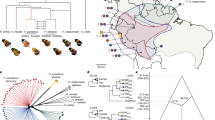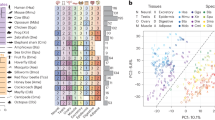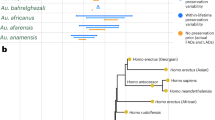Abstract
Over the course of evolution, organism size has diversified markedly. Changes in size are thought to have occurred because of developmental, morphological and/or ecological pressures. To perform phylogenetic tests of the potential effects of these pressures, here we generated a dataset of more than ten thousand descriptions of insect eggs, and combined these with genetic and life-history datasets. We show that, across eight orders of magnitude of variation in egg volume, the relationship between size and shape itself evolves, such that previously predicted global patterns of scaling do not adequately explain the diversity in egg shapes. We show that egg size is not correlated with developmental rate and that, for many insects, egg size is not correlated with adult body size. Instead, we find that the evolution of parasitoidism and aquatic oviposition help to explain the diversification in the size and shape of insect eggs. Our study suggests that where eggs are laid, rather than universal allometric constants, underlies the evolution of insect egg size and shape.
This is a preview of subscription content, access via your institution
Access options
Access Nature and 54 other Nature Portfolio journals
Get Nature+, our best-value online-access subscription
$29.99 / 30 days
cancel any time
Subscribe to this journal
Receive 51 print issues and online access
$199.00 per year
only $3.90 per issue
Buy this article
- Purchase on Springer Link
- Instant access to full article PDF
Prices may be subject to local taxes which are calculated during checkout




Similar content being viewed by others
Data availability
The dataset of insect eggs is publicly available at Dryad (https://datadryad.org) with doi:10.5061/dryad.pv40d2r and has been described elsewhere24. The phylogenetic posterior distributions are provided as Supplementary Information (phylogeny_posterior distribution_misof_backbone.nxs and phylogeny_posterior_distribution_rainford_backbone.nxs).
Code availability
All code required to reproduce the analyses and figures shown here is available at https://github.com/shchurch/Insect_Egg_Evolution.
References
Peters, R. H. The Ecological Implications of Body Size (Cambridge Univ. Press, 1983).
Allen, R. M., Buckley, Y. M. & Marshall, D. J. Offspring size plasticity in response to intraspecific competition: an adaptive maternal effect across life-history stages. Am. Nat. 171, 225–237 (2008).
Blanckenhorn, W. U. The evolution of body size: what keeps organisms small? Q. Rev. Biol. 75, 385–407 (2000).
Kingsolver, J. G. & Pfennig, D. W. Individual-level selection as a cause of Cope’s rule of phyletic size increase. Evolution 58, 1608–1612 (2004).
Stanley, S. M. An explanation for Cope’s rule. Evolution 27, 1–26 (1973).
LaBarbera, M. Analyzing body size as a factor in ecology and evolution. Annu. Rev. Ecol. Syst. 20, 97–117 (1989).
Chown, S. L. & Gaston, K. J. Body size variation in insects: a macroecological perspective. Biol. Rev. Camb. Philos. Soc. 85, 139–169 (2010).
Hinton, H. E. Biology of Insect Eggs vols I–III (Pergammon, 1981).
Thompson, D. W. On Growth and Form (Cambridge Univ. Press, 1917).
Fox, C. W. & Czesak, M. E. Evolutionary ecology of progeny size in arthropods. Annu. Rev. Entomol. 45, 341–369 (2000).
Berrigan, D. The allometry of egg size and number in insects. Oikos 60, 313–321 (1991).
García-Barros, E. Body size, egg size, and their interspecific relationships with ecological and life history traits in butterflies (Lepidoptera: Papilionoidea, Hesperioidea). Biol. J. Linn. Soc. 70, 251–284 (2000).
Stoddard, M. C. et al. Avian egg shape: form, function, and evolution. Science 356, 1249–1254 (2017).
Bernardo, J. The particular maternal effect of propagule size, especially egg size: patterns, models, quality of evidence and interpretations. Am. Zool. 36, 216–236 (1996).
Hinton, H. E. Respiratory systems of insect egg shells. Annu. Rev. Entomol. 14, 343–368 (1969).
Legay, J. M. Allometry and systematics of insect egg form. J. Nat. Hist. 11, 493–499 (1977).
Blackburn, T. Evidence for a ‘fast-slow’ continuum of life-history traits among parasitoid Hymenoptera. Funct. Ecol. 5, 65–74 (1991).
Kratochvíl, L. & Frynta, D. Egg shape and size allometry in geckos (Squamata: Gekkota), lizards with contrasting eggshell structure: why lay spherical eggs? J. Zoological Syst. Evol. Res. 44, 217–222 (2006).
Bilder, D. & Haigo, S. L. Expanding the morphogenetic repertoire: perspectives from the Drosophila egg. Dev. Cell 22, 12–23 (2012).
Steele, D. & Steele, V. Egg size and duration of embryonic development in Crustacea. Int. Rev. Gesamten Hydrobiol. Hydrograph. 60, 711–715 (1975).
Sargent, R. C., Taylor, P. D. & Gross, M. R. Parental care and the evolution of egg size in fishes. Am. Nat. 129, 32–46 (1987).
Maino, J. L. & Kearney, M. R. Ontogenetic and interspecific metabolic scaling in insects. Am. Nat. 184, 695–701 (2014).
Iwata, K. & Sakagami, S. F. Gigantism and dwarfism in bee eggs in relation to the modes of life, with notes on the number of ovarioles. Jap. J. Ecol. 16, 4–16 (1966).
Church, S. H., Donoughe, S. D., de Medeiros, B. A. S. & Extavour, C. G. A dataset of egg size and shape from more than 6,700 insect species. Sci. Data https://doi.org/10.1038/s41597019–0049-y (2019).
Misof, B. et al. Phylogenomics resolves the timing and pattern of insect evolution. Science 346, 763–767 (2014).
Rainford, J. L., Hofreiter, M., Nicholson, D. B. & Mayhew, P. J. Phylogenetic distribution of extant richness suggests metamorphosis is a key innovation driving diversification in insects. PLoS ONE 9, e109085 (2014).
Leiby, R. & Hill, C. The polyembryonic development of Platygaster vernalis. J. Agric. Res. 28, 829–839 (1924).
Houston, T. F. Brood cells, life-cycle stages and development of some earth-borer beetles in the genera Bolborhachium, Blackburnium and Bolboleaus (Coleoptera: Geotrupidae), with notes on captive rearing and a discussion of larval diet. Aust. Entomol. 55, 49–62 (2016).
Goldberg, J. et al. Extreme convergence in egg-laying strategy across insect orders. Sci. Rep. 5, 7825 (2015).
Harmon, L. J. et al. Early bursts of body size and shape evolution are rare in comparative data. Evolution 64, 2385–2396 (2010).
Uyeda, J. C., Hansen, T. F., Arnold, S. J. & Pienaar, J. The million-year wait for macroevolutionary bursts. Proc. Natl Acad. Sci. USA 108, 15908–15913 (2011).
Cooper, N. & Purvis, A. Body size evolution in mammals: complexity in tempo and mode. Am. Nat. 175, 727–738 (2010).
Peters, R. H. & Wassenberg, K. The effect of body size on animal abundance. Oecologia 60, 89–96 (1983).
Sieg, A. E. et al. Mammalian metabolic allometry: do intraspecific variation, phylogeny, and regression models matter? Am. Nat. 174, 720–733 (2009).
Polilov, A. A. Small is beautiful: features of the smallest insects and limits to miniaturization. Annu. Rev. Entomol. 60, 103–121 (2015).
Gillooly, J. F., Brown, J. H., West, G. B., Savage, V. M. & Charnov, E. L. Effects of size and temperature on metabolic rate. Science 293, 2248–2251 (2001).
Felsenstein, J. Phylogenies and the comparative method. Am. Nat. 125, 1–15 (1985).
Rensch, B. Histological changes correlated with evolutionary changes of body size. Evolution 2, 218–230 (1948).
Rainford, J. L., Hofreiter, M. & Mayhew, P. J. Phylogenetic analyses suggest that diversification and body size evolution are independent in insects. BMC Evol. Biol. 16, 8 (2016).
Gregory, T. R. Coincidence, coevolution, or causation? DNA content, cell size, and the C-value enigma. Biol. Rev. Camb. Philos. Soc. 76, 65–101 (2001).
Gregory, T. R. Animal Genome Size Database. Release 2.0 http://www.genomesize.com (2019).
Roff, D. A. The evolution of flightlessness in insects. Ecol. Monogr. 60, 389–421 (1990).
Whiting, M. F., Bradler, S. & Maxwell, T. Loss and recovery of wings in stick insects. Nature 421, 264–267 (2003).
Trueman, J., Pfeil, B., Kelchner, S. & Yeates, D. Did stick insects really regain their wings? Syst. Entomol. 29, 138–139 (2004).
Stancă-Moise, C. et al. Migratory species of butterflies in the surroundings of Sibiu (Romania). Sci. Pap. Ser. Manage. Econ. Eng. Agric. Rural Dev. 16, 319–324 (2016).
Ivanova-Kasas, O. M. in Developmental Systems: Insects vol. 1 (eds Counce, S. J. & Waddington, C. H.) Ch. 5, 243–271 (Academic, 1972).
Cooper, N., Thomas, G. H., Venditti, C., Meade, A. & Freckleton, R. P. A cautionary note on the use of Ornstein Uhlenbeck models in macroevolutionary studies. Biol. J. Linn. Soc. 118, 64–77 (2016).
Nieves-Uribe, S., Flores-Gallardo, A., Hernández-Mejía, B. C. & Llorente-Bousquets, J. Exploración morfológica del corion en Biblidinae (Lepidoptera: Nymphalidae): aspectos filogenéticos y clasificatorios. Southwest. Entomol. 40, 589–648 (2015).
Barata, J. M. S. Morphological aspects of Triatominae eggs. II. Macroscopic and exochorial characteristics of ten species of the genus Rhodnius Stal, 1859 (Hemiptera - Reduviidae) (in Portuguese). Rev. Saude Publica 15, 490–542 (1981).
Iwata, K. The comparative anatomy of the ovary in Hymenoptera (records on 64 species of Aculeata in Thailand, with descriptions of ovarian eggs). Mushi 38, 101–109 (1965).
Dutra, V. S., Ronchi-Teles, B., Steck, G. J. & Silva, J. G. Egg morphology of Anastrepha spp. (Diptera: Tephritidae) in the fraterculus group using scanning electron microscopy. Ann. Entomol. Soc. Am. 104, 16–24 (2011).
Patterson, D., Mozzherin, D., Shorthouse, D. P. & Thessen, A. Challenges with using names to link digital biodiversity information. Biodivers. Data J. 4, e8080 (2016).
Pyle, R. L. Towards a global names architecture: the future of indexing scientific names. ZooKeys 550, 261–281 (2016).
Rees, J. A. & Cranston, K. Automated assembly of a reference taxonomy for phylogenetic data synthesis. Biodivers. Data J. 5, e12581 (2017).
Hinchliff, C. E. et al. Synthesis of phylogeny and taxonomy into a comprehensive tree of life. Proc. Natl Acad. Sci. USA 112, 12764–12769 (2015).
GBIF. GBIF: The Global Biodiversity Information Facility https://www.gbif.org/en/ (2018).
Clark, J. The capitulum of phasmid eggs (Insecta: Phasmida). Zool. J. Linn. Soc. 59, 365–375 (1976).
Markow, T. A., Beall, S. & Matzkin, L. M. Egg size, embryonic development time and ovoviviparity in Drosophila species. J. Evol. Biol. 22, 430–434 (2009).
Glöckner, F. O. et al. 25 years of serving the community with ribosomal RNA gene reference databases and tools. J. Biotechnol. 261, 169–176 (2017).
Quast, C. et al. The SILVA ribosomal RNA gene database project: improved data processing and web-based tools. Nucleic Acids Res. 41, D590–D596 (2013).
Yilmaz, P. et al. The SILVA and “all-species Living Tree Project (LTP)” taxonomic frameworks. Nucleic Acids Res. 42, D643–D648 (2014).
Pruesse, E., Peplies, J. & Glöckner, F. O. SINA: accurate high-throughput multiple sequence alignment of ribosomal RNA genes. Bioinformatics 28, 1823–1829 (2012).
Smith, S. A. & Brown, J. W. Constructing a broadly inclusive seed plant phylogeny. Am. J. Bot. 105, 302–314 (2018).
Jetz, W., Thomas, G. H., Joy, J. B., Hartmann, K. & Mooers, A. O. The global diversity of birds in space and time. Nature 491, 444–448 (2012).
Ronquist, F. et al. MrBayes 3.2: efficient Bayesian phylogenetic inference and model choice across a large model space. Syst. Biol. 61, 539–542 (2012).
Maino, J. L., Pirtle, E. I. & Kearney, M. R. The effect of egg size on hatch time and metabolic rate: theoretical and empirical insights on developing insect embryos. Funct. Ecol. 31, 227–234 (2017).
Beaulieu, J. M., O’Meara, B. C. & Donoghue, M. J. Identifying hidden rate changes in the evolution of a binary morphological character: the evolution of plant habit in campanulid angiosperms. Syst. Biol. 62, 725–737 (2013).
Harmon, L. J., Weir, J. T., Brock, C. D., Glor, R. E. & Challenger, W. GEIGER: investigating evolutionary radiations. Bioinformatics 24, 129–131 (2008).
Pennell, M. W., FitzJohn, R. G., Cornwell, W. K. & Harmon, L. J. Model adequacy and the macroevolution of angiosperm functional traits. Am. Nat. 186, E33–E50 (2015).
Revell, L. J. phytools: an R package for phylogenetic comparative biology (and other things). Methods Ecol. Evol. 3, 217–223 (2012).
Rabosky, D. L. Automatic detection of key innovations, rate shifts, and diversity-dependence on phylogenetic trees. PLoS ONE 9, e89543 (2014).
Rabosky, D. L. et al. Bamm tools: an R package for the analysis of evolutionary dynamics on phylogenetic trees. Methods Ecol. Evol. 5, 701–707 (2014).
Paradis, E., Claude, J. & Strimmer, K. APE: analyses of phylogenetics and evolution in R language. Bioinformatics 20, 289–290 (2004).
Pinheiro, J. et al. nlme: linear and nonlinear mixed effects models. R package version 3.1-117 https://cran.r-project.org/web/packages/nlme/index.html (2014).
Revell, L. J. Phylogenetic signal and linear regression on species data. Methods Ecol. Evol. 1, 319–329 (2010).
Tung Ho, L. s. & Ané, C. A linear-time algorithm for Gaussian and non-Gaussian trait evolution models. Syst. Biol. 63, 397–408 (2014).
Beaulieu, J. M., Jhwueng, D.-C., Boettiger, C. & O’Meara, B. C. Modeling stabilizing selection: expanding the Ornstein–Uhlenbeck model of adaptive evolution. Evolution 66, 2369–2383 (2012).
Acknowledgements
This work was supported by the National Science Foundation (NSF) under grant no. IOS-1257217 to C.G.E., NSF GRFP DGE1745303 to S.H.C. and by a Jorge Paulo Lemann Fellowship to B.A.S.d.M. from Harvard University. We thank members of the Extavour laboratory and B. Farrell, C. Dunn, D. McCoy, D. Rice, A. Kao, E. Kramer, J. Boyle, L. Bittleston, M. Srivastava, M. Johnson, P. Wilton, R. Childers and S. Prado-Irwin for discussion, and the Ernst Mayr Library at the Museum of Comparative Zoology at Harvard, and specifically M. Sears, for assistance in gathering references.
Reviewer information
Nature thanks Clay Cressler and the other anonymous reviewer(s) for their contribution to the peer review of this work.
Author information
Authors and Affiliations
Contributions
S.H.C. and S.D. conceived the project and generated the dataset. S.H.C. performed statistical analyses. B.A.S.d.M. performed phylogenetic analyses. All authors contributed to experimental design, interpretation and writing.
Corresponding authors
Ethics declarations
Competing interests
The authors declare no competing interests.
Additional information
Publisher’s note: Springer Nature remains neutral with regard to jurisdictional claims in published maps and institutional affiliations.
Supplementary information
Supplementary Information
This document contains Supplementary Methods, Supplementary Figures S1-S24, and Supplementary Tables S1-S22. These provide additional methodological details, a more complete description of the diversity of insect eggs, ancestral state reconstructions, and evolutionary model fitting results.
Supplementary Information
This file contains the Egg Dataset Bibliography. This document is a list of the 1,756 published sources that were used to generate the assembled dataset of insect egg traits.
Supplementary Information
This nexus file contains 100 phylogenetic trees randomly sampled from the posterior distribution, assembled using the Rainford et al. 2014 (ref. 26 in the main text) phylogeny as a backbone.
Supplementary Information
This nexus file contains 100 phylogenetic trees randomly sampled from the posterior distribution, assembled using the Misof et al. 2014 (ref. 25 in the main text) phylogeny as a backbone.
Rights and permissions
About this article
Cite this article
Church, S.H., Donoughe, S., de Medeiros, B.A.S. et al. Insect egg size and shape evolve with ecology but not developmental rate. Nature 571, 58–62 (2019). https://doi.org/10.1038/s41586-019-1302-4
Received:
Accepted:
Published:
Issue Date:
DOI: https://doi.org/10.1038/s41586-019-1302-4
This article is cited by
-
A high throughput method for egg size measurement in Drosophila
Scientific Reports (2023)
-
Evolutionary History and host Ecology Determine Acanthocephalan Egg Shape
Evolutionary Biology (2023)
-
Egg Morphology of Two Neotropical Dragonflies: Micrathyria hesperis and Miathyria simplex (Odonata: Libellulidae)
Neotropical Entomology (2023)
-
Fertilization mode differentially impacts the evolution of vertebrate sperm components
Nature Communications (2022)
-
Nuclear speed and cycle length co-vary with local density during syncytial blastoderm formation in a cricket
Nature Communications (2022)
Comments
By submitting a comment you agree to abide by our Terms and Community Guidelines. If you find something abusive or that does not comply with our terms or guidelines please flag it as inappropriate.



